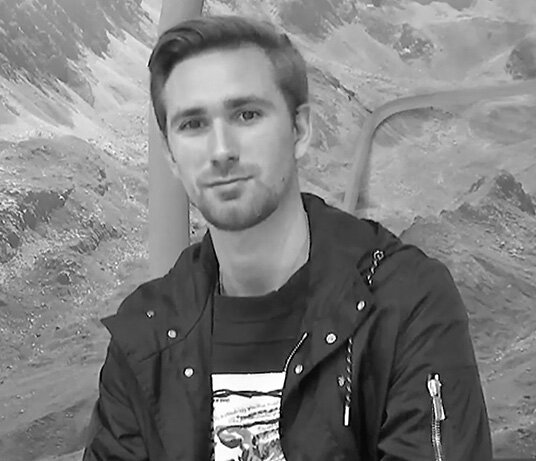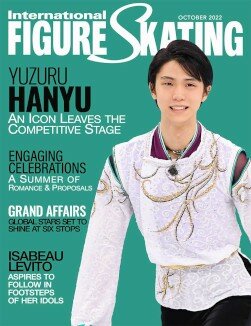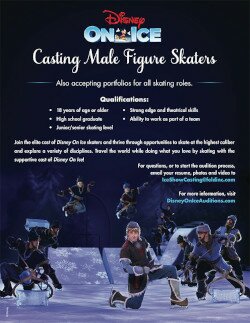

Figure skating careers develop in many different ways. Some find success at an early age and rise to the top of the sport. Others have lengthy careers, slowly working their way up the ladder. Some stay in the sport a long time but never find success. And then there are those who turn to coaching and/or choreography and discover themselves on the other side of the boards. That was the life scenario that rolled out for Russia’s Daniil Gleikhengauz.
The 29-year-old, who competed in singles and ice dance, had little success on the frozen stage. However, he found his calling on the other side of the boards as a coach and choreographer and is now part of one of the most successful coaching teams in the world for singles skaters.
There was a chance that Daniil Gleikhengauz would never have become a figure skater. His father, Mark, worked in the film industry and his mother, Liudmila Shalashova, was a ballerina who performed with the Bolshoi Theatre in Moscow. She wanted her son to follow in her footsteps, but since children in Russia only start ballet around 7 years of age, she put her then 4-year-old into figure skating first.
Gleikhengauz said that when the time came for him to be put into ballet, he had already fallen in love with figure skating. He recalled crying and screaming that he did not want to do ballet. Figure skating had become his first love. A talented athlete, he trained with well-known Russian coaches such as Natalia Dubinskaia and Viktor Kudriavtsev. In 2007, Gleikhengauz claimed the bronze medal at the Russian junior nationals and qualified for the World Junior Championships. Unfortunately, he suffered an ankle injury in practice at that competition and finished a distant 19th. “I had surgery and I tried to recover, but jumping was still painful for me,” Gleikhengauz recalled. Despite those problems, he continued for three more years.
At age 18, he realized he was no longer competitive in singles but was not yet ready to retire, so he switched to ice dance. “It was hard. I was learning ice dance for a year. Like many singles skaters, I thought that singles was hard and ice dance was easy, but that is not the case.”
Coached by Alexander Zhulin, Gleikhengauz and his partner, Ksenia Korobkova, competed at the junior level internationally during the 2011-2012 season, winning two small events (NRW Trophy in Germany and the Pavel Roman Memorial in the Czech Republic). However, at the Russian Junior Championships the following year, they finished 11th, which left them with no hope of earning a spot on the team for Junior Worlds.
When he aged out of the junior ranks Gleikhengauz decided to quit skating. After his father passed away in 2010 he felt he needed to start earning money to support himself and his mother. “I started to coach and choreograph. They gave me some skaters to work with at my old school, Moskvich, where I had trained in singles,” Gleikhengauz recalled. “I coached at ice rinks in shopping malls, and worked with recreational skaters — with whoever wanted to have lessons.”
The skating boom had started to take hold in Russia, which offered many new opportunities. Gleikhengauz started working for Ilia Averbukh, the 2002 World ice dance champion, who produces shows and tours across Russia. “I was with Averbukh for three years. The first year I was in the ice ballet group, the second year I got solo numbers and in the third year I wanted to stop,” he said with a laugh.
When Julia Lipnitskaia became the overnight darling of the 2014 Olympic Winter Games in Sochi, her coach, Eteri Tutberidze, also became famous. Her group of skaters was growing and Tutberidze and Sergei Dudakov, who were already working together, were looking for an assistant who was a skating skills expert. Gleikhengauz had worked with Averbukh on his “Carmen on Ice” production and the impresario recommended him to Tutberidze. In the fall of 2014, the then 23-year-old joined the team at the Sambo 70 Club and never looked back.
He quickly became a full member of the team, working as a coach and choreographer. The most common misunderstanding he encounters is that people believe there are different roles for the coaches in the group. “In fact, all of us are fully involved in the whole training process, from practicing skating skills, teaching jump technique, music selection, costumes, hairstyles and image projection, to stretching and cooling down,” Gleikhengauz explained.
“Sergei Dudakov does all that as well with the exception of choreography, but this is the only thing he isn’t doing. We are together at practices every day. Over the years, we have united our vision and our ideas about technique and other things. We don’t disagree. We are all thinking the same way. We explain, demonstrate, and teach the same way so there is no confusion for the athletes, that one coach says one thing and another coach says something different. For our students, we are one unit.”
Last season, the coaching team had many skaters competing at the junior and senior levels. Their senior group included Alena Kostornaia, Anna Shcherbakova, Alexandra Trusova, Alina Zagitova, and Morisi Kvitelashvili (who is Russian but represents Georgia). Kamila Valieva, Daria Usacheva, Maiia Khromykh, Daniil Samsonov, and Georgia’s Nika Egadze all competed on the junior circuit, with others in the group competing at the national level. That in itself was a scheduling nightmare, with the coaches all travelling to different competitions with a variety of skaters.
When you see him at the boards at competitions, Gleikhengauz appears calm and relaxed and always has a smile for the skaters as they leave the ice. Sometimes he looks like a kindergarten teacher surrounded by children. However, he can be demanding and strict, particularly in practice where he will call a skater to order who is struggling and getting upset.
“I can’t compare myself to Eteri and Sergei because I don’t have children,” the Moscow native admitted. “But all our athletes are like children to me. I don’t want to have my own children right now because there is enough excitement, nerves and educational moments with the students. I feel like a big dad or even a mom that has a number of children.”
Gleikhengauz said it is not an easy task to balance all the skaters that are at a high level and that they, as coaches, need to find an individual approach for each athlete. “If someone can’t do a quad, then we won’t force them and squeeze all the juice out of them. If they can’t do it, that means they have other strengths. They can improve their skating skills to the maximum, to make the elements that they can do ideal, and show the maximum of character in the programs. Each person has their strengths, and it is our job to help the athlete to fully discover their potential.”
While he cares about the young people he trains, Gleikhengauz also feels it is important to keep a professional distance. “We talk a lot with our skaters, but they do not tell us very personal things,” he said. “They say what they are doing, what they want to buy, and the girls talk about manicures and whatever. We laugh, we joke, talk, and look something up on the Internet together, but all this cannot develop into a friendship-like relationship because otherwise the subordination suffers. The athlete should not have any fear but should understand that next to him is an adult who is always supportive, who knows what to say and how to help so that the skater can improve. Everything depends on trust.
“The most important thing is that you cannot lie to the athlete. When he or she does something poorly, you cannot say, ‘it is great, extraordinary.’ It is better right away to call a spade a spade and say, ‘You need to go and do it again.’ Of course, we feel our body, but you always can judge better from the outside. This is how trust develops. When you trust the words of your coach independently of your own feelings you go and do it again. Then the relationship between coach and athlete develops the right way.”
Tutberidze and Gleikhengauz choreographed most of the programs for their skaters last season and found very different music and styles to reflect the different characters of their students. The delicate Shcherbakova; the fierce Trusova; the elegant Zagitova; the expressive Kostornaia, and the fairy-like Valieva. Finding the perfect program for each person is always the hardest part. “I want already to turn to the musicians and composers and ask them to work faster and write more new music,” Gleikhengauz said with a laugh. “I’ve used almost the complete works of some composers like Max Richter, Dario Marianelli and others. They need to work faster, like we do. Somehow we are mounting a lot of programs and they are writing just a few pieces of music.”
Gleikhengauz said he and Tutberidze usually collaborate on the choreography. “She is always helping me and we do the programs together. For such a large number of programs you need to have a lot of ideas. Without each other, this would be incredibly difficult.”
They also tap into very different genres to get ideas. “Almost everything can be the source of inspiration, such as ballet — or an art form like Eteri’s ‘Girl on the Ball’ program for Valieva — and movies or musicals. Sometimes, when I am listening to music through my headphones, I start to imagine how this could look on the ice. If I like it and I feel it could be interesting, then I take it to the ice to try it out.”
For him, good choreography means that the program is complete from beginning to end and that it suits the skater. “You can think of something incredible and you believe that it is a masterpiece, but all this remains only in your head if you don’t bring it across the right way on the ice, individually for each athlete,” Gleikhengauz explained. “The most important thing is that there is not too much ‘me’ — so that the athlete can express him or herself and present it from the best side, and not in a way that the choreographer did it.”
Gleikhengauz crafted a special exhibition number for Zagitova that he dedicated to his mother, who passed away unexpectedly in August 2019 (video link below). He said the idea was born in his mind three days after it happened. “I came to practice and told Alina about this idea and she said, ‘don’t you want to skate this program yourself in a show?’ That was really nice of her. I wanted to pass on my idea and the program through her, but for that I thank her very much. The concept of the program is about life — how we come into this world, take our first steps and how we live. Happiness, joy, pain, disappointment … all the emotions we encounter in this life. At the end of the program, she stops, turns around, and looks back at her life. She smiles, lies down and from her hand a flower emerges that symbolizes a new life. It is like a reincarnation. It was maybe easier for me this way to overcome my loss.”
His mother had also worked with Tutberidze’s team for many years and did a lot of work with all the skaters on the floor. She was close to Zagitova and worked with her on the two ballet programs — “Black Swan” and “Don Quixote” — that she competed in the 2017-2018 Olympic season. “They were very close. Alina presented my mom with a kitten for her birthday. The cat lives now with me,” he said.
When the season ended earlier than expected, the skaters and coaches were forced to take an unplanned break following the closure of all the ice rinks in Moscow. Gleikhengauz said he used his time off to come up with new and unique ideas for next season’s programs.
Zagitova Exhibition Number
(This article was originally published in the IFS May/June 2020 issue)




